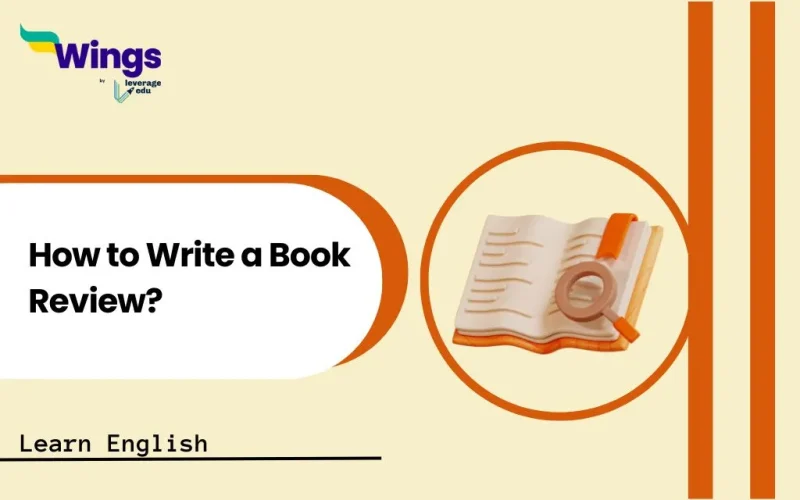How to Write a Book Review? Writing a book review is a great way to share your thoughts about a book and help others decide if they should read it. A good review is more than just a summary—it includes your honest opinion, highlights the book’s strengths and weaknesses, and explains what makes it special.
Whether you’re a student writing a book review for school or a reader who wants to share opinions online, this guide will help you write a clear, engaging, and helpful review. Let’s break it down step by step!
This Blog Includes:
What is a Book Review?
A book review is a personal yet structured evaluation of a book. It goes beyond simply summarizing the plot—it involves analyzing themes, characters, and writing style while expressing your honest opinion.
Book reviews are helpful in many ways.
- For students, writing a book review improves thinking and analysis skills. It helps them understand the book and share their opinions.
- In magazines and websites, book reviews help readers decide if they should read a book. They give a short summary and explain what to expect.
Also Read: Must-read Motivational Books for Students, Men, and Women
Why Write a Book Review?
There are various reasons for writing a book review. Here we have mentioned a few of them:
- Help To Choose The Right Book: Your review can help the reader choose the right book to read.
- Improves Your Analytical Skills: Reviewing books hones your ability to think critically.
- Engages You in the Reading Community: Book reviews spark conversations with fellow readers and authors.
How to Write a Book Review?
Writing a book review is a great way to share your thoughts on a book and help others decide if they should read it. A well-written review goes beyond just summarizing the book—it includes analysis, personal opinions, and recommendations. Follow this step-by-step guide to craft a compelling book review.
1. Start with Basic Details
Begin your review by providing the essential details about the book. This helps readers quickly understand what the review is about.
What to include:
- Book Title
- Author’s Name
- Genre (Fiction, Non-fiction, Mystery, Romance, etc.)
- Publication Date (Optional)
Example:
Book Title: The Alchemist
Author: Paulo Coelho
Genre: Fiction, Inspirational
Published: 1988
2. Write a Brief Summary (Without Spoilers!)
Give a short summary of the book in your own words. This should provide an overview of the story or main theme without giving away major spoilers.
Tips for writing a good summary:
- Keep it concise: Just enough for readers to understand the plot.
- Avoid spoilers: Don’t reveal important twists or the ending.
- Highlight the main theme: What is the book about at its core?
Example: ‘The Alchemist” follows the journey of Santiago, a young shepherd who dreams of finding treasure. His quest takes him across the desert, where he meets wise mentors who teach him valuable lessons about life, destiny, and following one’s dreams.’
This is the most important part of the review! Share what you personally thought about the book.
Questions to consider:
- What did you like? (Characters, plot, writing style, message)
- What didn’t work for you? (Slow pacing, underdeveloped characters, weak conclusion)
- Did the book engage you? (Did it hold your interest? Did it evoke emotions?)
Example: ‘ I loved “The Alchemist” for its simplicity and deep life lessons. The writing style is poetic and easy to understand. However, I found some parts repetitive, as certain messages were repeated multiple times throughout the book.’
4. Highlight Key Strengths & Weaknesses
Every book has its strong points and weak spots. Mention them clearly and fairly.
| Strengths | Weakness |
| Well-developed characters Engaging storyline Thought-provoking themes | Repetitive messages Some scenes felt slow |
Example: ‘One of the biggest strengths of “The Alchemist” is its powerful message about following one’s dreams. However, some readers might find the repetition of these lessons a bit overwhelming.’
5. Use Examples to Support Your Points
Adding specific examples makes your review stronger. You can include:
- A favorite quote from the book.
- A scene that stood out to you.
Example: One of my favorite quotes from The Alchemist is:
“When you want something, all the universe conspires in helping you to achieve it.”
This line beautifully captures the book’s theme about believing in one’s dreams.
6. Rate the Book & Give Recommendations
Give a rating (out of 5 stars) and suggest who might enjoy the book.
Things to mention:
- Your rating (1-5 stars)
Who would like this book? (Fantasy lovers, history buffs, self-help readers)
Example: Rating: 4.5/5
Recommendation: This book is perfect for readers who love inspiring stories and philosophical lessons. If you enjoy books like The Little Prince or Tuesdays with Morrie, you’ll love The Alchemist.
7. Wrap Up with a Conclusion
End your review by summarizing your overall thoughts and whether you would recommend the book.
Example: The Alchemist” is a simple yet powerful book filled with wisdom about life and destiny. While some parts are repetitive, its message about following dreams makes it a worthwhile read. I would definitely recommend it to those looking for an uplifting and motivational book.
Also Read: Importance of Books in Our Life
Samples: How to Write a Book Review
Here are some samples to help you write a book review.
Example 1: Fiction Book Review
Book Title: The Great Gatsby by F. Scott Fitzgerald
Review: F. Scott Fitzgerald’s The Great Gatsby is a timeless classic that captures the essence of the Roaring Twenties, a period of unprecedented wealth, excess, and social change in America. First published in 1925, this novel is widely regarded as one of the greatest works of American literature, exploring themes of love, ambition, class, and the illusion of the American Dream.
Set in the summer of 1922, the novel is narrated by Nick Carraway, a Yale graduate and World War I veteran who moves to West Egg, Long Island, to pursue a career in the bond business. His neighbor, Jay Gatsby, is a wealthy and enigmatic man known for throwing extravagant parties. However, Gatsby’s wealth and opulence mask his deep yearning for Daisy Buchanan, a woman he once loved and lost. Daisy, now married to the affluent but morally corrupt Tom Buchanan, represents Gatsby’s unattainable dream. As the story unfolds, Gatsby’s relentless pursuit of Daisy and his idealized vision of the past ultimately lead to his tragic downfall.
One of the novel’s greatest strengths is its lyrical prose and evocative imagery. Fitzgerald’s writing is poetic, painting a vivid picture of the Jazz Age with its dazzling parties, reckless indulgence, and moral decay. The novel’s symbolism, particularly the green light at the end of Daisy’s dock, represents Gatsby’s dreams and the broader idea of the American Dream—an aspiration that proves elusive and ultimately unattainable.
The characters in The Great Gatsby are deeply flawed yet compelling. Gatsby is both admirable and tragic; his boundless hope and idealism contrast with the materialistic world he inhabits. Daisy, on the other hand, embodies the superficiality of the elite, while Tom represents the arrogance and entitlement of the old-money class. Nick serves as an observer, grappling with his own moral dilemmas as he witnesses the unraveling of Gatsby’s dream.
Beyond its critique of the American Dream, The Great Gatsby explores themes of social stratification, the corruption of wealth, and the loss of innocence. The novel remains profoundly relevant, offering insights into the human condition and the pursuit of happiness.
In conclusion, The Great Gatsby is a beautifully crafted novel that continues to captivate readers nearly a century after its publication. Fitzgerald’s masterpiece is more than a story of love and ambition; it is a poignant reflection on the dreams we chase and the realities we face. Whether read for its literary brilliance or its timeless themes, The Great Gatsby is a must-read for anyone seeking to understand the complexities of human desires and societal expectations.
Example 2: Non-Fiction Book Review
Atomic Habits by James Clear is a powerful self-improvement book that explores the science behind habit formation. Clear provides actionable insights on how small, consistent changes can lead to remarkable results. The book is based on behavioral psychology and neuroscience, making it both practical and evidence-based.
Summary of the Book
The central idea of Atomic Habits is that small, incremental changes—atomic habits—can lead to significant personal and professional growth over time. Clear introduces the Four Laws of Behavior Change as a framework for building good habits and breaking bad ones:
- Make it Obvious – Design your environment to make good habits easy to start.
- Make it Attractive – Associate positive emotions with good habits.
- Make it Easy – Reduce friction by breaking habits into smaller steps.
- Make it Satisfying – Reinforce habits with rewards and positive reinforcement.
Key Takeaways
The Power of 1% Improvement: Clear emphasizes that improving by just 1% each day can lead to exponential growth over time. This principle highlights the power of compounding small actions.
Identity-Based Habits: Rather than focusing on goals, Clear suggests focusing on identity. Instead of saying, “I want to run a marathon,” he advises identifying as a runner, which makes the habit more sustainable.
The Role of Environment: Clear argues that habits are not just about willpower but also about shaping the environment to make good behaviors easier and bad behaviors harder.
Habit Stacking: A practical strategy he suggests is “habit stacking,” which involves linking new habits to existing ones. For example, if you want to start reading more, you can decide to read a page right after making your morning coffee.
Strengths of the Book
- Actionable Advice: The book provides practical steps that readers can implement immediately.
- Scientific Backing: Clear references psychological studies to support his claims.
- Engaging Writing Style: The book is easy to read and filled with relatable examples.
Criticism
While Atomic Habits is highly insightful, some critics argue that it repeats concepts and could be more concise. Additionally, while the book provides strategies, actual implementation still requires strong personal discipline.
Conclusion
Atomic Habits is a must-read for anyone looking to build positive habits, increase productivity, and create lasting change. With its clear strategies and compelling insights, it serves as a practical guide to self-improvement. Whether you’re looking to break bad habits or establish new ones, this book provides a structured approach to making lasting transformations.
Bonus Tips to Write a Good Book Review
A well-written book review helps readers decide whether to pick up a book. Follow these simple tips to make your review clear, engaging, and useful.
- Don’t Just Repeat the Story: A book review is not just a summary of the book. Instead of retelling the story, share your thoughts. What did you like? What didn’t you like? How did the book make you feel? Give your personal take rather than just describing what happens.
- Keep It Short and Clear: People read book reviews to decide if they should read the book. So, don’t write long paragraphs full of unnecessary details. Stick to the main points—what’s good, what’s not, and why. A short and clear review is more helpful.
- Explain Your Opinions: If you loved or disliked something, explain why. For example, instead of saying, “The book was boring,” you could say, “The story was slow, and there wasn’t much action.” Giving reasons helps others understand your review better.
- Check for Mistakes: Before sharing your review, read it again to fix any spelling or grammar mistakes. A well-written review looks more professional and is easier to read. You can also read it out loud to see if it sounds natural.
FAQs on How to Write a Book Review
A book review is a personal opinion on a book, discussing its strengths and weaknesses, rather than just summarizing the plot.
It depends on the platform. A short review can be 100-300 words, while a detailed one may be 500-1000 words.
Mention the book’s title, author, a brief summary (without spoilers), what you liked or disliked, and your overall rating or recommendation.
No, avoid spoilers or clearly mark them with a warning so you don’t ruin the book for others.
Use simple language, share personal opinions, and give specific reasons for your likes and dislikes.
Yes, but mention that you didn’t finish it and explain why.
If relevant, yes! Comparing it to similar books can help readers understand its style and quality.
Related Reads
We hope this blog on “How to Write a Book Review” helped you improve your English skills. You can also follow the Learn English page of Leverage Edu for more exciting and informative blogs related to English grammar and the English language.
 One app for all your study abroad needs
One app for all your study abroad needs















 45,000+ students trusted us with their dreams. Take the first step today!
45,000+ students trusted us with their dreams. Take the first step today!


